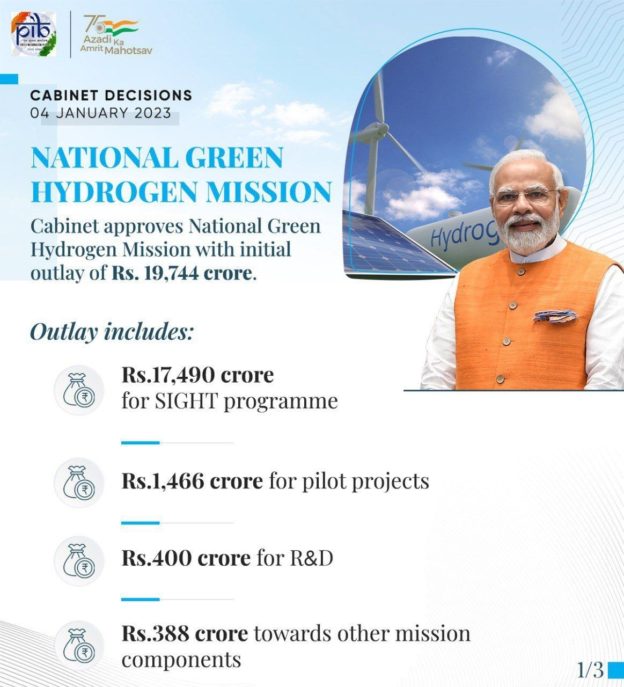There are opportunities for the traditional energy partners to cooperate through knowledge sharing and investments in Green Hydrogen.
India began 2023 underlining its commitment to renewable energy through a giant step of approving the National Green Hydrogen Mission. On 4 January the Cabinet approved the National Green Hydrogen Mission with an initial outlay of Rs.19,744 crore. By 2030, the mission aims to achieve green hydrogen production capacity of 5 MMT (Million Metric Tonne) per annum, creation of over six lakh jobs, cumulative reduction in fossil fuel imports over one lakh crore and abatement of nearly 50 MMT of annual greenhouse gas emissions.
The expected long-term benefits of the mission will include creation of export opportunities for Green Hydrogen and its derivatives; and decarbonization of industrial, mobility and energy sectors. It will also lead to the reduction in India’s dependence on imported fossil fuels and feedstock as New Delhi will develop considerable indigenous manufacturing capabilities. The creation of employment opportunities for the young demography and the development of cutting-edge technologies will be added advantages.
As India proactively aims at increasing stakes in Green Hydrogen, it is prudent to extend hands of cooperation to its age-old energy partners in the Gulf. India depends on the Gulf Cooperation Council (GCC) countries for the majority of its energy needs; they contribute almost 35 per cent of India’s oil imports and 70 per cent of gas imports. Even though the ultimate aim of the Green Hydrogen mission is to reduce New Delhi’s energy dependence, India will continue to import oil and gas until it achieves complete transitions from fossil fuels to renewable energy.
India as well as the GCC countries are favorably placed to invest into Green Hydrogen energy. GCC countries have the potential to become hydrogen producers as well as exporters as they have existing industrial capacity and required capital to invest in the initial infrastructure. These countries also have abundance of inexpensive land and water along with solar and wind resources that can help in production of Green Hydrogen. More importantly, the countries are situated in geographical proximity to the emerging and future markets for cleaner fuel. Lastly, the GCC countries can easily be producers of Blue Hydrogen due to availability of hydrocarbons and the carbon capture, utilization and storage (CCUS) capacity.
Similarly, India is well placed to delve into the production of hydrogen energy. It has a distinct advantage in low-cost renewable energy generation which makes Green Hydrogen the most competitive form of hydrogen in the long run. As per a NITI Ayog report of June 2022, adoption of Green Hydrogen will lead to 3.6 Giga Tonnes of CO2 emissions reductions between 2020 and 2050. Also, Green Hydrogen will result in energy import savings ranging from US$246 billion to US$358 billion within the same period.
Green Hydrogen provides an opportunity for India and its GCC partners to expand their cooperation and collaborations on renewable energy. GCC members are seeking investments in the hydrogen sector; Saudi Arabia intends to attract more than US$36 billion of investment by 2030 under its National Hydrogen Strategy. The UAE is planning to build a hydrogen industry ecosystem and seeks investors to build hydrogen export facilities. Oman aims to produce one million Tonnes of Green Hydrogen by 2030 and hopes to attract US$20 billion investment in the sector in the same period.
There are opportunities for the traditional energy partners to cooperate through knowledge sharing and investments in Green Hydrogen. India has made considerable investments on research and development as well as the related technological advancements and has entered into collaborations with its energy partners in GCC. India’s efforts at extending and fostering time-tested energy ties through venturing into Green Hydrogen under is timely and laudable.
Abu Dhabi National Oil Company (ADNOC) and GAIL India have signed an MoU regarding collaboration in Green Hydrogen. Similarly, ACME India has opted for Oman for its first large scale green ammonia commercial project. Though India has extended its Green Hydrogen cooperation with the regional countries beyond GCC including Egypt, the focus should now be on providing momentum to these efforts and expand the Green Hydrogen collaborations with other members of the GCC. India should forge collaborations with Saudi Arabia that focused on Blue Hydrogen under its circular carbon economy vision during its G20 presidency in 2020.
India shares a time-tested and strong energy partnership with the GCC countries and the energy partners stand with each as they accelerate transition to cleaner and renewable sources and are keen to achieve the decarbonization goals. They also aim to generate employment for their young population while reducing their dependence on fossil fuels.
The National Green Hydrogen Mission thus generates newer opportunities for India and the GCC States to strengthen partnership in the renewable energy sector complimenting their robust partnership in the oil and gas sectors.
https://www.financialexpress.com/defence/national-green-hydrogen-mission-creates-opportunities-for-strengthening-indias-renewable-energy-partnership-with-gcc-countries/2945017/?utm_source=defence_landing_page&utm_medium=article_listing_widget&utm_campaign=Tags





